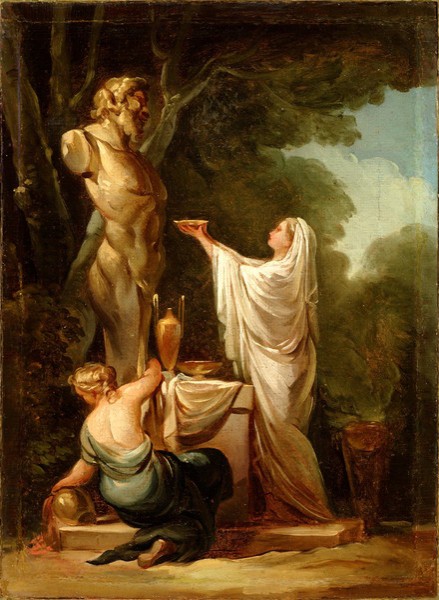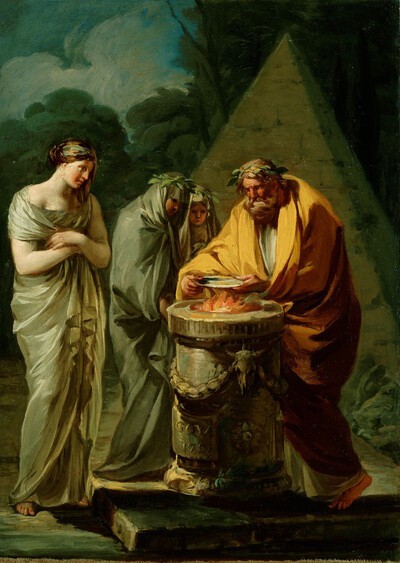- Cronología
- Ca. 1771
- Ubicación
- Private collection, Zaragoza, Zaragoza, Spain
- Dimensiones
- 33 x 24 cm
- Técnica y soporte
- Oil on canvas
- Reconocimiento de la autoría de Goya
- Attributed work
- Titular
- Private collection
- Ficha: realización/revisión
- 16 Feb 2010 / 13 Jun 2023
- Otros títulos:
-
Sacrifice to Priapus (Sacrificio a Príapo)
This work was produced during Goya's stay in Italy. José Milicua published the work for the first time together with its possible companion painting, Sacrifice to Vesta in 1954.
In 1913 it was auctioned in Paris as part of the Eugène Kramer collection, lot number 106, and was bought by Maurice Boilloux Lafont. In 1953 it was acquired by a Swiss private collector. Later it belonged to the collection of José Gudiol, and then to his heirs until it was later acquired by its current owner.
The scene is set in a forest, where we can see a priestess proffering a golden bowl to the statue of Pan, god of fertility and masculine sexuality. At the foot of the sculpture there is an altar upon which there are other recipients used in the libation rite. A young woman who is bending down with her back to us is handling the pitcher of wine.
It has also been argued that the painting might also represent the minor god Priapus, since Pan was usually portrayed with goat's feet, arms and hands. Here we have a herma, which was commonly used to represent Priapus, the god of fertility of the land.
There are some doubts as to the authenticity of this painting, which is traditionally paired with Sacrifice to Vesta. While the works shared a common provenance until recent times, and their mythological character and Roman details link them, it is also true that the canvas seems to have been deliberately stretched to make it the same size as its supposed companion work. Moreover, there is a second version of this work (known to have been in a Parisian private collection in the 1970s) which seems not to have been painted by Goya, in which the god appears to have been considerably altered, adding some elements associated with Pan.
If this work is indeed by Goya, then it would doubtless have been painted - as experts agree - during his stay in Rome, as one of the quickly executed paintings which the artist produced to pay for his upkeep.
For more information on this kind of work, see Sacrifice to Vesta.
-
Goya and his timesThe Royal Academy of ArtsLondon1963cat. 66cat. 43
-
El arte de GoyaMuseo de Arte Occidental de TokioTokyo1971from 16th 1971 to January 23th 1972. Exhibited also at the Kyoto Municipal Museum of Art, January 29th to March 15th 1972.cat. 2
-
Goya joven (1746-1776) y su entornoMuseo e Instituto Camón AznarZaragoza1986consultant editorl José Rogelio Buendía. November 21st to December 20th 1986cat. 13
-
Goya y el espíritu de la IlustraciónMuseo Nacional del PradoMadrid1988from October 6th to December 18th 1988. Exhibited also at Museum of Fine Arts, Boston, January 18th to March 26th 1989; The Metropolitan Museum of Art, Nueva York, May 9th to July 16th 1989, Madrid curator Manuela B. Mena Marqués, scientific directors Alfonso E. Pérez Sánchez and Eleanor A. Sayrecat. 2
-
Goya e ItaliaMuseo de ZaragozaZaragoza2008organized by the Fundación Goya en Aragóna, consultant editor Joan Sureda Pons. From June 1st to September 15th 2008cat. 148
-
Zaragoza2021
-
“Anotaciones al Goya joven”Paragone1954pp. 19-21
-
Vie et ouvre de Francisco de GoyaParísOffice du livre1970p. 82, cat. 23
-
BarcelonaPolígrafa1970vol. I, p. 237, cat. 15
-
L’opera pittorica completa di GoyaMilanRizzoli1974p.89, cat. 17
-
Francisco de Goya, 4 vols.ZaragozaCaja de Ahorros de Zaragoza, Aragón y Rioja1980-1982vol. I, p. 51 y p. 32 (il.)
-
Goya e Italia, 2 vols.ZaragozaFundación Goya en Aragón y Turner2008vol. II, p. 238, cat. 148
-
Goya. Traveler and artist of the Grand Tour (exp. cat.)ZaragozaGobierno de Aragón2021pp. 126-127

